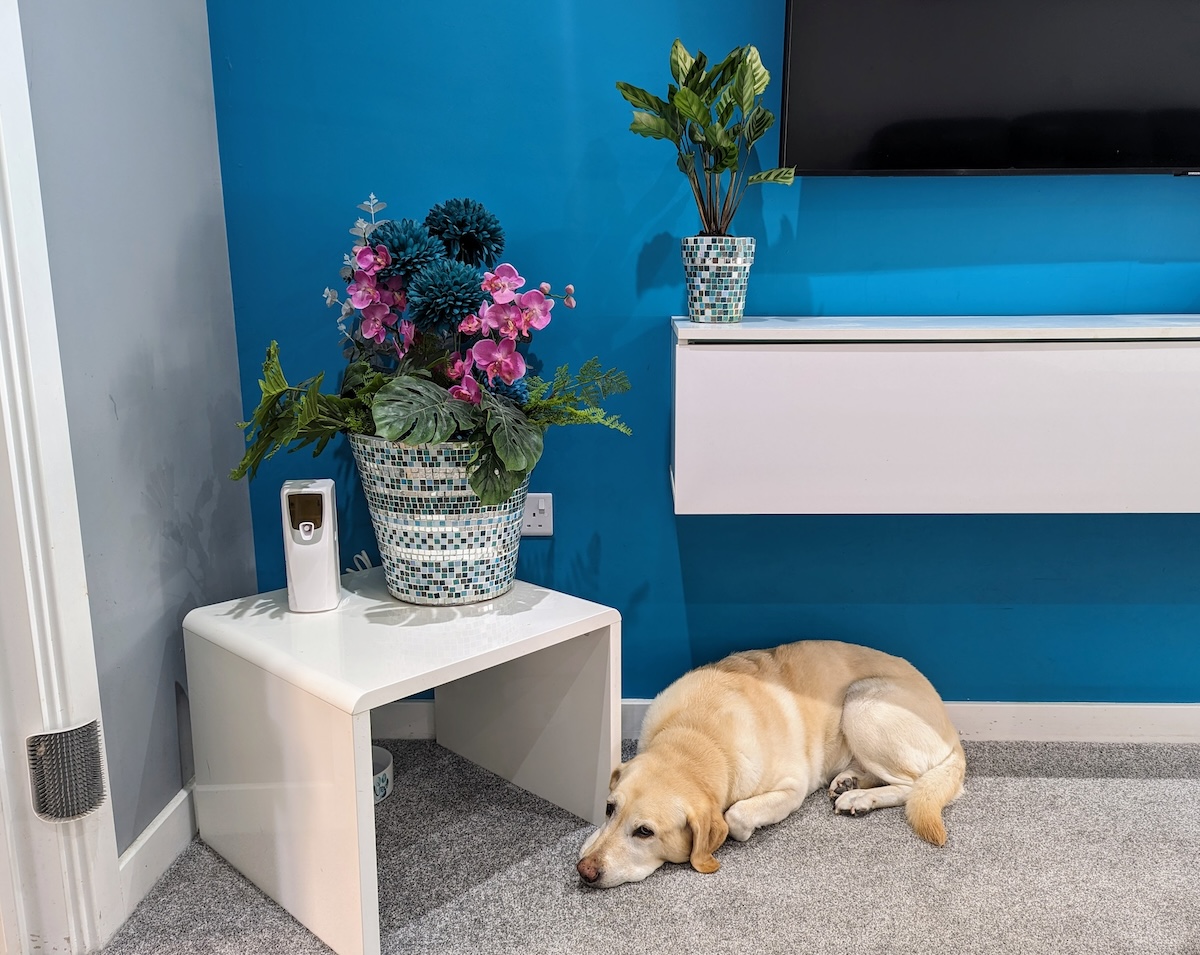
Hi, I’m Dr. Karyn. Read my introduction to learn more about me and my five funny dogs, Poppy, Bailey, Kodah, Ned, and Fred.
Bailey has been a member of our family even longer than I have. When my husband, Reece, and I blended our families, I added one cat (Clutch) to his household of two cats and three dogs. Finn, the Irish Wolfhound is no longer with us, but Poppy and Bailey are still going strong, although their beach trips have evolved from manic running to pottering about. As expected, they both have some arthritis, but thanks to the hip replacement surgery she had when she was younger, Bailey’s arthritis isn’t as bad as it could have been. Although they are on medication to help manage the pain and inflammation, slowing down is inevitable, and we have made adjustments to their beds, exercise, and daily routines to make sure they are getting the most out of their retirement.
What we haven’t managed to help with is Bailey’s panic attacks. Around 2-3 years ago, Bailey started having episodes of panting, quivering, and shaking uncontrollably, that seemed to come from nowhere.
She’s always been a bit of a sensitive girl, shying away from raised voices (even when raised in enthusiasm, not anger), and happy to take her lead from Poppy. Her favorite things are meeting new people (particularly children) and dogs, going to the beach, and carrots. When playing with another dog, Bailey tends to take on a submissive role, always rolling on her back, tail wagging madly, but she’ll soon tell a dog off if they get too rough. She’s the type of dog you would trust around kids, cats, and any other animal, but never around food. Her sweet and gentle nature quickly makes her the favorite of any visitors to our home. She is the ideal dog.
Better Outside Than In
Sadly, Bailey’s panic and anxiety periods have become longer and more frequent, but we have found that she quickly settles down as soon as she goes outside. On a warm sunny day, I have no problem with that – she should be enjoying good weather as much as she can, infrequent though it may be here in the UK. But her desperation to stay outside is persisting through all seasons, and I have to call her several times before she reluctantly comes back inside.

What made it worse was that she would insist on lying on the cold, hard floor of our patio, even if I put a bed or blanket outside. Ironically, she finally started sleeping on some soft bedding when I placed a crate on the patio and lined it with a mattress and blankets. I say ironic, because despite her apparent desperation to be outside the house, she finds peace inside her crate.
So what’s going on?
Checking the Physical
The first thing I did was conduct a thorough physical examination, looking for any changes, pain, or abnormalities that might explain her troubling behavior, and here’s what I found:
- Blood tests – all normal
- Mild arthritis of both stifles (knees) for which she is on anti-inflammatory medication
- Grade 2-3 heart murmur – blood test and echocardiogram are both normal
- Appetite is normal, but if she is having a panic episode, she will only eat outside
- No vomiting or diarrhea
- Drinking and urination normal
- No abdominal pain or palpable abnormalities
- No lumps, bumps, or tumors
- Mild tartar on teeth but no sign of significant dental disease
- Mild bilateral nuclear sclerosis – a normal cloudy change in eyes in older dogs
- Her vision and hearing appear to be normal
- Neurological examination unremarkable
Satisfied that her physical health was okay – excellent really, for a dog of 11 years – I moved onto looking at the psychological. What was causing Bailey’s panic attacks?

Companions, Changes, or Claustrophobia?
In many cases, it is easy to pinpoint a trigger, change, or presence that is giving a dog anxiety. With Bailey, we have made very little headway in our efforts to work out what is causing her episodes. In an attempt to narrow it down, we have started looking backwards into her (and our) history to see what could be triggering her. What has made this process difficult is that we cannot recall exactly when her panic attacks started; the first time it happened, we did not know it was to become a regular occurrence. So we created a Timeline of Bailey to try to narrow things down.
The Timeline of Bailey
As you can see, Bailey has seen a lot of comings and goings over the years, but has seemingly taken it all in her stride. The one we dread would be Poppy going before Bailey; she has never known life without Poppy, who despite only being 4 weeks older, has always been very much the ‘big sister’ to her yellow companion.

Questions We Ask
Is it Cornwall?
Cornwall was a regular holiday destination for Bailey before we made it our permanent home. She loves the beach, but she did occasionally get anxious in new locations.

Is it the house?
It’s a new build, so there are no strange sounds, creaking floorboards, or ghosts!
Has she become progressively anxious with every new pet that passes away/enters?
It’s certainly possible – it’s so hard that she can’t talk to us.
Is it having lively young dogs around as she is getting older?

This one is definitely a concern and would explain why things have escalated over the past few years, and why she wants to be outside (if the youngsters are inside). But she also instigates wrestling and play with Kodah, Ned and Fred, so I’m not convinced that this is a constant concern, or enough to be turning her into a quivering, panting mess.
Also, were this her main trigger, I would expect her anxiety to increase when the younger dogs join her outside, or perhaps have her wanting to come inside when they are out, and this isn’t the case. She appears to be just as relaxed outdoors whether she is alone or with the other dogs.
What Have We Tried?

Apart from providing her with a cozy, safe space outside, I have tried Bailey with a number of treatments, from supplements like Yumove, pheromone diffusers and collars like Adaptil, calming sprays like Pet Remedy, a Thundershirt, Trazodone, which is an anti-anxiety medication, even acupuncture, with none of them having a significant or long-lived effect. Everything I have tried seems to help for a short while, but then the panic returns. It’s starting to give me anxiety!
What’s Next For Bailey?
Right now, allowing her to spend as much time outside as possible is our ‘sort-of solution’, and not such a bad one in the milder months of the year. We may need to look at building her something a little more substantial before next winter if we can’t crack the source of this problem.
If you have had a similar problem with your dogs, or have any insights or ideas about my situation, I’d love to hear from you.


